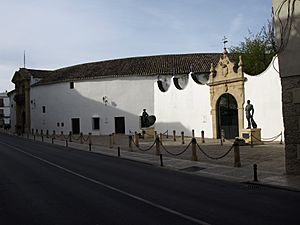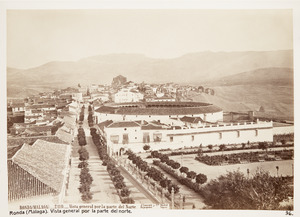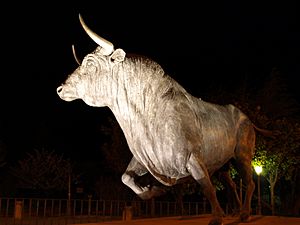Plaza de Toros de Ronda facts for kids
The Plaza de Toros de Ronda is a famous bullring located in Ronda, a beautiful city in Spain. It's a very old and special place. The bullring is about 66 meters wide. It has two stone rings that form a passage around the main area.
Inside, there are two levels of seats. Each level has five rows. There are also 136 pillars that create 68 arches. The special Royal Box has a sloped roof with Arabic tiles. The main entrance is grand, with two large columns and the royal shield of Spain. This door is big enough for horses and carriages to enter. Above it is a cool iron balcony that shows off the history of bullfighting.
Contents
History of the Ronda Bullring
Ronda is home to the Real Maestranza de Caballería. This is Spain's oldest and most respected horsemanship group. It started way back in 1485. That year, King Ferdinand and Queen Isabella took Ronda back from the Moors. This ended over 700 years of Islamic rule.
Building the bullring began in 1779 and finished in 1785. It sits on the west side of Ronda. It's not far from the famous Puente Nuevo bridge and the El Tajo canyon. The architect Martín de Aldehuela is believed to have designed it.
This bullring might not be the very oldest in Spain. However, it was one of the first built completely from stone. Many others used a mix of stone and brick. Its design is also special because all the seats are covered. It's considered a smaller arena with about five thousand seats. But the actual bullfighting ring itself is the largest in Spain.
The first bullfight event in May 1784 had a problem. Part of the stands collapsed! The bullring had to close for repairs. It reopened the next year in May 1785. This second opening event was one of the greatest bullfights in Ronda's history. Famous rivals Pedro Romero and Pepe Hillo faced each other. Many important families from Ronda watched.
Over the years, the area around the bullring changed. In 1923, the Espinel theater was built next to the main entrance. Later, the entrance moved to Virgen de la Paz street. In the 1980s, the old theater was taken down for a parking lot. By 2009, the parking lot was removed. Now, beautiful gardens stretch next to the bullring entrance. These gardens celebrate the golden age of bullfighting.
Famous Bullfighters
Soon after the bullring was built, the Romero family became famous. They were from Ronda and produced many generations of bullfighters. The most important was Pedro Romero (1754-1839). He was a key figure in bullfighting history. He fought more than 5,600 bulls!
The Romero and Ordóñez families were known for their amazing bullfights here. You can see bronze statues of Cayetano Ordóñez and his son Antonio Ordóñez outside one of the entrances. Antonio Ordóñez created the Feria Goyesca. This is a special bullfight held every year in the first week of September. It honors Pedro Romero. The Ordóñez family, another famous bullfighting family, takes part in this event. Bullfighters and their helpers dress in costumes like those in paintings by Francisco Goya.
Because Ronda is a smaller town, this bullring doesn't host as many bullfights as bigger places like Seville. The Ronda bullring is open to visitors. In 2023, the admission fee was EUR 9.00.
Museum at the Bullring
The bullring also has a museum inside. It's called the Museo Taurino. This museum shows off two centuries of famous bullfighting gear and important outfits. It also has many weapons used by the Real Maestranza in Spanish wars. The museum is open all year. It closes only during the Feria week in September. The cost to enter is 9.00 euros.
Other Uses of the Bullring
The Ronda bullring has been used for more than just bullfights! In 1994, the American singer Madonna filmed her music video for "Take A Bow" here. She had planned to invite fans to be extras, but that idea changed. Madonna's co-star in the video was Spanish bullfighter Emilio Muñoz.
In 2001, the bullring was also a location for a TV show. It was used for the final quiz and challenge in the first season of the American reality TV show The Mole. Anderson Cooper hosted the show.
See also
 In Spanish: Plaza de toros de Ronda para niños
In Spanish: Plaza de toros de Ronda para niños





